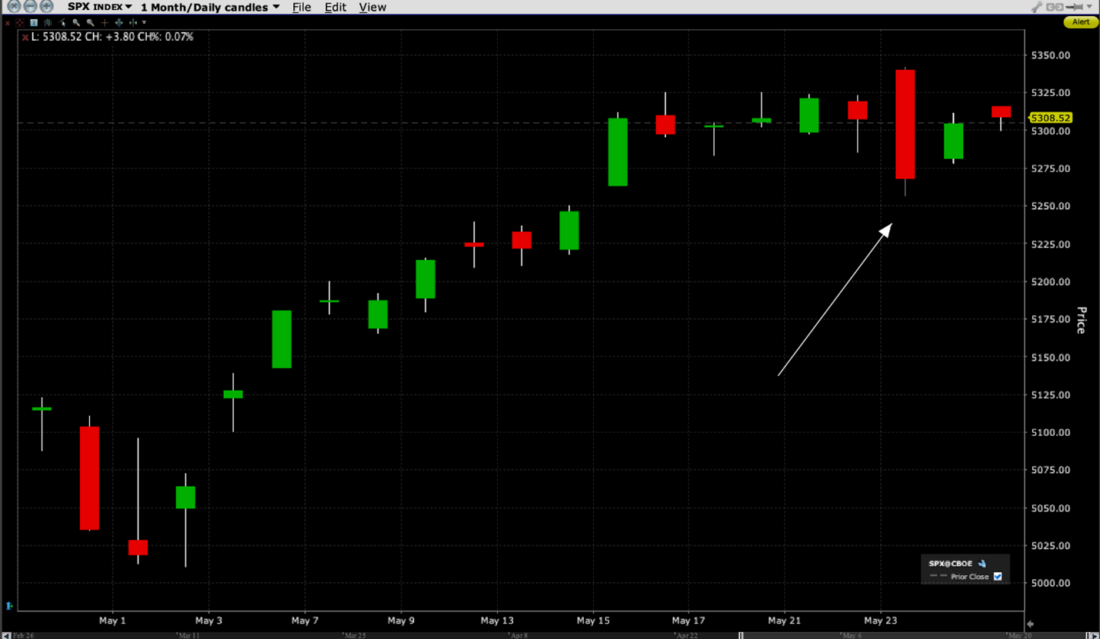A popular refrain that I’ve heard recently is that “Sell in May” hasn’t worked this year. Indeed, so far it hasn’t. But all we really know is that “Sell in April” and “Sell in early May” haven’t worked. We won’t, or can’t, know if “Sell in May” worked until June at the earliest.
Quite frankly, when major indices are at or near all-time highs it is obvious that selling at any time prior would have been a mistake – at least if you hold index funds linked to those indices. Some stocks go down even in the broadest advances, but since we tend to focus on macro rather than micro analysis, we will be talking about the market as a whole rather than specific names.
To be clear, I believe that NVDA’s latest beat and raise was a savior. That the S&P 500 (SPX) and Nasdaq 100 (NDX) indices both fell sharply on Thursday while NVDA rose over 8% in a post-earnings rally was anomalous, but imagine how far we might have fallen if that stock led the plunge. And of course all things were largely forgiven the next day, as SPX recouped all its prior day’s losses. Today at midday, we see SPX up less than 0.1%, almost all of which can be attributed to NVDA’s 5% rise.
Much of today’s rise is considered the positive mojo of NVDA’s upcoming stock split. Even though stock splits are essentially meaningless to institutional investors — and I will assert of similar “benefit” to individuals in an era when fractional shares and listed options are readily available to small investors – the psychological effect has value. It’s another of those situations where if enough people think it is a positive, then it becomes one. It could mean that downticks in NVDA will be few and far between now and the ex-split date of June 10th, and that when they do arise, the “buy the dip” activity would keep them modest.
Then what? It is quite possible that the bigger the rally before the split, the more likely it becomes a “sell the news” event. Unless there is a groundswell of new investors waiting to pounce on NVDA after it splits AND despite a further rally, the split will simply be the equivalent of getting ten $1 for a $10 – useful, but not a meaningful uptick in value. The other factor to reckon with is whether the continued rush into NVDA and other semiconductor stocks is resulting from new money coming into the market or whether existing money is simply being reallocated.
Until last week, it appeared that the “new money” was the catalyst. After Thursday, I’m less sure. In recent weeks we saw a healthy rotation from the cadre of leading stocks into a wider array of market sectors. Since then, the rallies appear to have narrowed out. Indeed, it is difficult – if not outright wrong – to draw conclusions from a small sample of days, but I can’t clear my head of the outside key reversal that we saw on Thursday. No chart pattern is foolproof, but this typically is a powerful one:
SPX 1-Month Daily Candles

Source: Interactive Brokers
Then what should we watch for between now and June 10th? First would be a break above Thursday’s intraday high. That would negate the reversal. Other than that, we would consider whether sentiment is too euphoric. There are signs that it might be.
- Citi’s “Levkovich Indicator” is now reading “euphoria”.
- Bank of America’s portfolio managers survey shows that institutional cash levels have fallen to a three-year low of 4% even as global growth expectations fell
- Even as VIX plumbs multi-year lows, the US composite put/call ratio does so too:
US Composite Put/Call Ratio (white) with 21-Day Moving Average (magenta) and VIX (red)

Source: Interactive Brokers
Does any of this definitively mean that we have seen the highs for now? Of course not. But major reversals are more likely to be triggered by the upsetting of an embedded consensus than slow changes in psychology. We certainly have the embedded consensus. We just don’t have the trigger – yet.
Join The Conversation
If you have a general question, it may already be covered in our FAQs. If you have an account-specific question or concern, please reach out to Client Services.
Leave a Reply
Disclosure: Interactive Brokers
The analysis in this material is provided for information only and is not and should not be construed as an offer to sell or the solicitation of an offer to buy any security. To the extent that this material discusses general market activity, industry or sector trends or other broad-based economic or political conditions, it should not be construed as research or investment advice. To the extent that it includes references to specific securities, commodities, currencies, or other instruments, those references do not constitute a recommendation by IBKR to buy, sell or hold such investments. This material does not and is not intended to take into account the particular financial conditions, investment objectives or requirements of individual customers. Before acting on this material, you should consider whether it is suitable for your particular circumstances and, as necessary, seek professional advice.
The views and opinions expressed herein are those of the author and do not necessarily reflect the views of Interactive Brokers, its affiliates, or its employees.



















The AI hype has gone over the top now. NVDA will NOT will NOT will NOT have a $4 TRILLION DOLLAR MARKET CAP. All call options of $1600 and higher will expire worthless ($160 after the split.) That is a guarantee. The option strikes which imply the possibility of a $5 Trillion valuation are ridiculous, but they all doubled today since that’s the way the options casino works. It’s not a favorite to reach $3.5 Trillion, and it even if it reaches $3 Trillion, which it is very close to, it may not stay there. If this were not an election year, I think the S&P would be 4800 tops. And of course the Nasdaq 100 is in Looney Land. The cost of living is going to take its toll on consumers at some point in the not-too-distant future, as inflation persists and prevents the Fed from lowering interest rates.